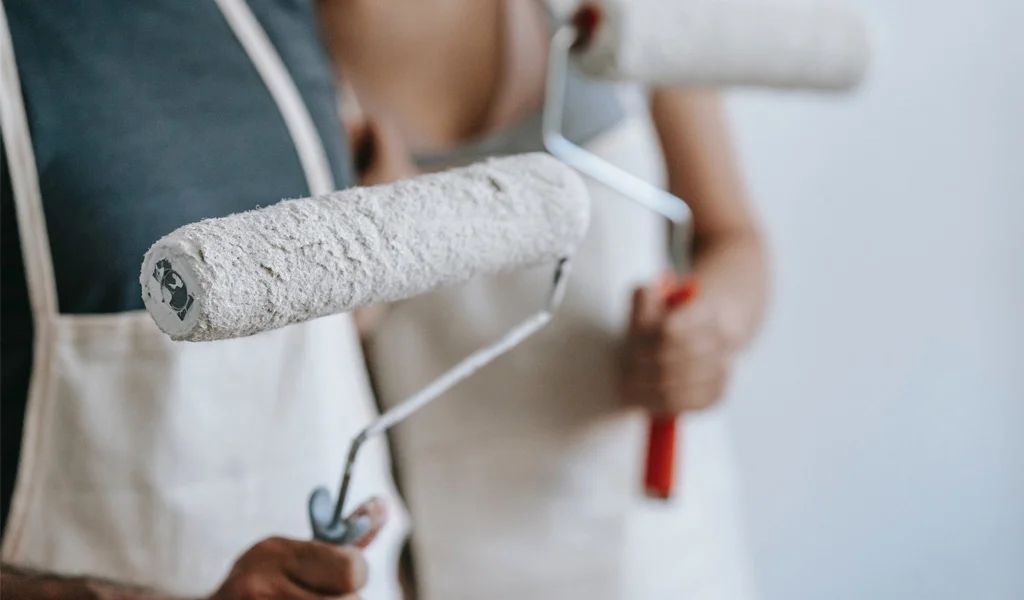When it comes to painting popcorn ceilings, homeowners often debate whether it’s better to spray or roll on the paint. Both spraying and rolling have their pros and cons when painting textured ceilings like popcorn. Here’s an in-depth look at the differences between spraying and rolling when painting popcorn ceilings.
Page Contents
Spraying Paint on Popcorn Ceilings
Using an airless paint sprayer is a common technique for painting popcorn ceilings. Here are some of the pros and cons of spraying paint:
Pros
- Spraying creates an even, consistent coat of paint.
- It’s faster than rolling and can cover a large ceiling quickly.
- Paint sprayers can easily get paint into all the nooks and crannies of textured popcorn ceilings.
- Overspray and drips are minimized since the paint is finely atomized.
Cons
- Spraying takes some practice and technique to get right.
- You need to protect nearby walls and floors from overspray.
- Textured paint buildup can happen if you apply too much paint.
- Airless sprayers require cleaning and maintenance.
Rolling Paint on Popcorn Ceilings
While less common than spraying, it’s also possible to apply paint to popcorn ceilings using paint rollers. Here are some pros and cons of rolling paint on popcorn ceilings:
Pros
- Rolling doesn’t require any special equipment – just a paint roller and extension pole.
- It’s a more controlled application of paint vs. spraying.
- There’s less mess, overspray, and preparation needed compared to spraying.
Cons
- Getting into all the crevices and textures takes more work with a paint roller.
- It takes significantly more time to roll ceilings vs. spraying.
- It can be tricky to get an even coat when rolling textured surfaces.
- More coats may be needed to fully cover the ceiling.
Which Is Better for Popcorn Ceilings: Spraying or Rolling?
So when considering speed, finish quality, and convenience – is spraying or rolling paint better for DIY popcorn ceiling painting?
For most homeowners, spraying is the preferred method for painting popcorn ceilings. Airless paint sprayers allow you to apply paint quickly and evenly to cover stippled or heavily textured ceilings. The fine spray can fully coat each kernel of popcorn while minimizing drips and shadows.
That said, spraying does require more prep work, practice, and clean-up. If you rent an airless sprayer and aren’t experienced with using one, you may end up with an uneven finish. And you’ll need tarps or drop cloths to protect the rest of the room from overspray.
Rolling paint onto popcorn ceilings is doable, but much more tedious. It takes more time and effort to work the paint roller over the bumpy surface and get into all the crevices. You may need to apply several coats to get full coverage. However, rolling does avoid the learning curve and overspray issues of spraying.
Tips for Spraying or Rolling Popcorn Ceilings
If you decide to spray your textured ceiling, follow these tips:
- Use painter’s tape and plastic sheeting to mask walls, windows, trim, and floors.
- Remove light fixtures and vent covers to spray separately.
- Practice spraying on cardboard to get the right distance and sweeping motion.
- Apply thin, even coats to avoid drips and texture buildup.
- Let the paint fully dry between coats.
For rolling paint on popcorn ceilings, these tips will help:
- Use a high quality roller with a 1-1.5″ nap suitable for rough surfaces.
- Work in small sections, applying paint in a zig-zag or back-and-forth pattern.
- Apply pressure as you roll to help work the paint into the grooves and texture.
- Blend sections together before the paint dries to create a seamless look.
- Plan to apply at least 2 coats, allowing proper drying time between coats.
Conclusion
In most cases, spraying is the best method for applying paint to popcorn ceilings. Airless sprayers deliver faster, more uniform coverage. However, rolling paint on instead can still get the job done if you have the time and patience. Prepare properly, work in sections, and apply multiple coats for the best results.
Whichever application method you choose, take steps to protect surrounding surfaces from paint drips and overspray. Allow sufficient drying time between coats. And use high quality primer and paint designed specifically for ceilings or textured surfaces. With the right prep and techniques, you can give dated popcorn ceilings a fresh new look.
